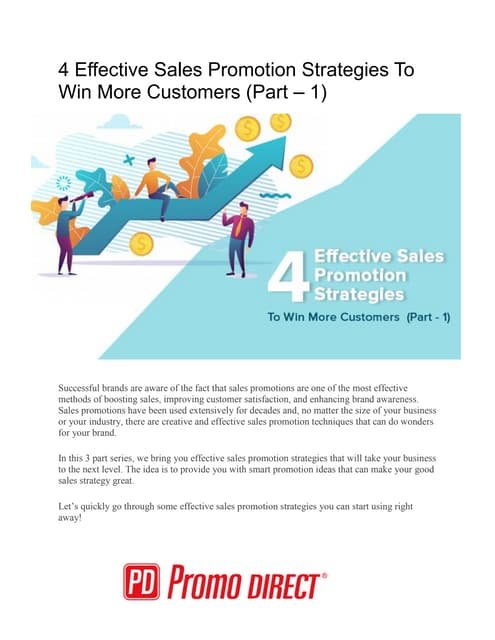[Maximizing Your Sales with Effective Promotional Programs]

Executive Summary

In today’s competitive marketplace, businesses need every advantage they can get. Promotional programs are a powerful tool for increasing sales, building brand awareness, and driving customer loyalty. However, not all promotional programs are created equal. To maximize their effectiveness, businesses need to carefully plan and execute their promotions, tailoring them to their target audience and business objectives. This article will explore key strategies for developing and implementing successful promotional programs, covering everything from identifying target audiences to measuring results.

Introduction
Promotional programs are a cornerstone of modern marketing. They allow businesses to reach new customers, engage existing ones, and drive sales. By offering incentives and creating excitement, promotions can effectively overcome price sensitivity, attract new customers, and stimulate repeat business. However, developing a successful promotional program requires more than simply offering discounts. It involves understanding your target audience, setting clear objectives, and strategically planning and executing your campaign. This article will delve into the essential components of effective promotional programs, equipping you with the knowledge and tools to maximize your sales and achieve your marketing goals.
Frequently Asked Questions
-
Q: How do I know if my promotional program is working?
A: It’s essential to track key metrics like sales, conversion rates, customer acquisition cost, and return on investment (ROI). Analyzing these metrics will help you understand the effectiveness of your promotions and make adjustments as needed.
-
Q: What are some common types of promotional programs?
A: There are many types, including discounts, loyalty programs, contests, giveaways, bundled offers, free shipping, and referral programs. The best type will depend on your specific goals and target audience.
-
Q: How do I create a budget for my promotional program?
A: Start by defining your goals and target audience. Then, research competitor promotions and industry benchmarks. Consider the cost of marketing materials, advertising, prizes, and discounts. Allocate funds strategically to maximize impact while staying within your budget.
Defining Your Target Audience
Understanding your target audience is crucial for crafting effective promotions. Knowing their demographics, interests, pain points, and buying habits will allow you to create offers and messaging that resonates with them.
-
Conduct thorough market research: Utilize surveys, focus groups, and data analysis to gain insights into your customer base.
-
Identify key demographics: Consider factors like age, gender, location, income, education level, and lifestyle.
-
Analyze customer behavior: Understand how customers interact with your brand, their purchase history, and their preferences.
-
Segment your audience: Divide your customers into groups based on shared characteristics to personalize promotions and messaging.
Setting Clear Objectives
Before launching any promotion, define clear, measurable objectives. This will help you focus your efforts and track your success.
-
Increase sales: Set specific sales targets for your promotion. Focus on boosting revenue and maximizing profit.
-
Drive website traffic: Use promotions to attract visitors to your website and increase online engagement.
-
Build brand awareness: Promote your brand to a wider audience and create positive associations with your products or services.
-
Generate leads: Use promotions to collect contact information for potential customers and nurture them through your sales funnel.
-
Boost customer loyalty: Encourage repeat purchases and foster long-term relationships with your customers.
Designing Engaging Promotions
Crafting compelling promotions that attract attention and drive conversions is essential. Consider the following factors:
-
Offer irresistible incentives: Provide valuable discounts, freebies, or exclusive offers that incentivize customers to take action.
-
Create a sense of urgency: Utilize limited-time offers, deadlines, and scarcity tactics to encourage immediate action.
-
Make it easy to participate: Simplify the redemption process and ensure customers can easily access and use their promotions.
-
Promote across multiple channels: Leverage email, social media, paid advertising, website banners, and in-store displays to reach your target audience.
-
Track and measure your results: Monitor key metrics to understand the effectiveness of your promotions and make adjustments as needed.
Leveraging Technology and Automation
Technology can significantly enhance your promotional efforts, streamlining processes and maximizing efficiency.
-
Email marketing: Use email automation to send personalized promotional emails based on customer behavior and preferences.
-
SMS marketing: Leverage text messages to deliver timely promotions and engage customers in real-time.
-
Social media advertising: Target your ideal audience on social media platforms with tailored promotional campaigns.
-
Customer relationship management (CRM) systems: Track customer interactions, personalize communications, and optimize your promotional strategies.
-
Marketing automation tools: Automate repetitive tasks, personalize communications, and improve the efficiency of your promotional campaigns.
Conclusion
Developing effective promotional programs is a crucial aspect of any successful business strategy. By understanding your target audience, setting clear objectives, designing engaging promotions, and leveraging technology, you can create campaigns that drive sales, boost brand awareness, and build customer loyalty. Remember to track your results, analyze your data, and continually refine your approach to maximize the impact of your promotional programs.
Keywords
- Promotional programs
- Marketing
- Sales
- Customer acquisition
- Brand awareness
- Customer loyalty
- Target audience
- Incentives
- Urgency
- Automation
- Technology